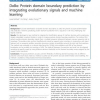Free Online Productivity Tools
i2Speak
i2Symbol
i2OCR
iTex2Img
iWeb2Print
iWeb2Shot
i2Type
iPdf2Split
iPdf2Merge
i2Bopomofo
i2Arabic
i2Style
i2Image
i2PDF
iLatex2Rtf
Sci2ools
BMCBI
2011
2011
DoBo: Protein domain boundary prediction by integrating evolutionary signals and machine learning
Background: Accurate identification of protein domain boundaries is useful for protein structure determination and prediction. However, predicting protein domain boundaries from a sequence is still very challenging and largely unsolved. Results: We developed a new method to integrate the classification power of machine learning with evolutionary signals embedded in protein families in order to improve protein domain boundary prediction. The method first extracts putative domain boundary signals from a multiple sequence alignment between a query sequence and its homologs. The putative sites are then classified and scored by support vector machines in conjunction with input features such as sequence profiles, secondary structures, solvent accessibilities around the sites and their positions. The method was evaluated on a domain benchmark by 10-fold cross-validation and 60% of true domain boundaries can be recalled at a precision of 60%. The trade-off between the precision and recall can...
| Added | 12 May 2011 |
| Updated | 12 May 2011 |
| Type | Journal |
| Year | 2011 |
| Where | BMCBI |
| Authors | Jesse Eickholt, Xin Deng, Jianlin Cheng |
Comments (0)

